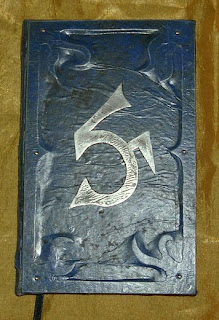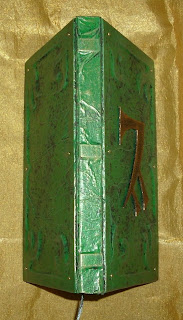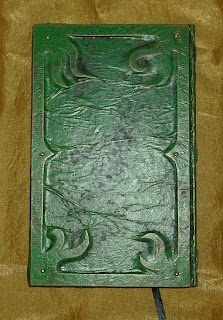Here is the fifth book in the encyclopedia re-cover series (aka Good Books Gone Bad). I call it "The Black Book of Evil." It
is up for sale on eBay right now was sold on eBay. As always, click through for larger images.

I used a different encyclopedia set this time; Encyclopedia Britannica. I picked them up recently at a thrift store for $1 per volume. I don't remember which volume this one is, and it's not in front of me to check (like it matters). This set had silver gilding on the page edges (actually, just on the top edge. I had to paint the other two edges to match) so it seemed like I should decorate this tome with a silver finish rather than my ubiquitous bronze. These books are nice and big and heavy. The finished product weighs about 4.25lbs. and measures 11.25" x 9.25" x 2.5".

First I recovered the book's hard cover with a dark black cotton fabric. That part went quite fast, as it covered rather nicely. Well, actually,
first I painted the two remaining raw edges,
then I recovered it in black cloth. Next I picked out my decorative pieces. I had to do a special run of resin castings because all the ones I had pre-made already had a base coat of bronze on them, and I didn't want to repaint them. I decided on tentacles at the corners and the baphomet head, which I have used before, for the centerpiece. There were a couple of small details that were different about these pieces. The centerpiece was an experiment I had done with using powdered nickel-silver brushed into the mold before pouring the resin and later polished with steel wool, so actually this piece was not painted (except for a black acrylic wash to antique it), but is closer to a cold-cast metal (at least on the surface). The tentacles are a new set. A month or two back, I decided I needed some more variety in my tentacle corner pieces, so I sculpted five new originals out of sculpy and made new molds of them. This is the first finished product that incorporates the new tentacle designs.

Up to this point, everything was pretty straight forward. Things got a little more complicated when it came to the closure. I'm always looking for new closure designs. I get tired of the same old brass hasp and hinges set-up that I've used multiple times. This time I went with a black leather strap which encircled the girth of the book. I riveted it to the front and back covers and placed the centerpiece right on top of the strap. Then I sat and pondered how I was going to close/lock it for about an hour. I had an idea to use a silvered buckle instead of a hasp and lock, but my locking silver buckles were too big. They didn't look right. I had a much smaller regular buckle, but that would require making the strap thinner at the buckle. After some ruminating and hesitating. I decided to go ahead and make a secondary strap that would rivet onto and over the main strap, that was the appropriate size for the smaller buckle. I tucked the main strap's ends between the text bock and the cover boards, and wrapped the smaller strap around the edge to buckle in the back. This was a time consuming process, not only because I had never tried to make this design before, but because I was making it up as I went along , and I had to wait 15 minutes for the glue to dry at each stage of its construction. If I had the design planned out better from the start, I could have saved a considerable amount of time. C'est la guerre.

I installed red end papers on the front and back covers. Before pasting them in, I picked out a couple of nice geometric sigils from the public domain and ran them through the printer. In the spine, I attached a heavy black cloth ribbon bookmark. Due to its width, I wish I would have attached it to the back cover instead of the spine, but I had already glued in the end papers. To finish off the end of the bookmark, I decided to attach a small resin casting of a piece of jewelry I used to carry in my shop. The company that designed it is out of business, I believe. It is a blazing sun with a skull and an equal armed cross at its center. I finished it in the antiqued silver, like all the rest of the resin pieces on this book.

Along the spine I did something different. Instead of attaching a title plate made from chipboard and hot glue, like I did on my last two books, I created some heavy cast resin glyphs to fix to the spine. To make them, I started with a piece of oil based modeling clay rolled flat. Then I measured the spine to decide on the dimensions of the glyphs. Once the size was determined, I made a grid on the clay, and in each square I carved out a glyph by hand. Once I had about eight glyphs carved into the slab (some for now, some for later), I poured resin right onto it. Cleaning out the clay from all the crevices, and trimming the flash was a little tedious. I also rounded the edges of each cast piece with a dremel. Then I finished them with the antique silver paint job and glued them to the spine.

I'm actually quite pleased with this tome. I think the finished product looks pretty good. This project saw several new innovations. It used the new tentacle castings on the corners. The centerpiece featured a cold cast metal finish instead of paint. The end papers were printed. The leather belt and buckle arrangement was a new design. The bookmark fob was new, and the raised resin glyphs on the spine are a first for me. This is the first of the new encyclopedia set, and it is the first of the re-cover series to be finished in silver. I also normally like to make these static props locking, but this one just has a buckle. I hope you enjoy it (and especially whomever buys it). As always, I am open to your comments.





































































